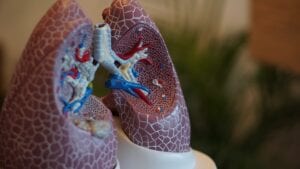Alveolar Capillary Dysplasia (ACD)
What is ACD?
Alveolar capillary dysplasia (ACD) is a rare genetic disorder of the lungs and blood vessels of the lungs present at birth. ACD is characterized by the poor development of the small blood vessels within the lungs known as capillaries. There are not enough capillaries for proper lung function. In addition the vessels that are present are not positioned correctly for proper function. This defect in the lungs vessels leads to high blood pressure in the lungs (pulmonary hypertension), inadequate oxygen delivery to the body and strain on the heart. The incidence of ACD is unknown. Approximately 200 cases have been documented. Due to frequent misdiagnosis the exact number of cases is unknown. ACD is also known as alveolar capillary dysplasia with misalignment of pulmonary veins (ACD/MCV).What are the symptoms of ACD?
Though the symptoms of ACD may not be apparent immediately at the time of birth, they do almost always present within minutes to days after birth. In rare occasions, infants my not show symptoms for weeks to a few months after birth. Symptoms of ACD include:- Lack of oxygen in blood stream (Hypoxia)
- Bluish discoloration of skin, lips and nail beds (Cyanosis)
- High blood pressure in the lungs (Pulmonary Hypertension)
- Shortness of breath
- Intestinal defects
- Urinary tract and kidney dysfunction
- Heart defects
What causes ACD?
In the majority of cases, ACD is cause by a mutation of a gene known as FOXF1 or chromosome 16. In about 10-20% of the cases of ACD the cause is unknown. Though ACD is not thought to be inherited, it is more common in families already affected by this disorder.Are there treatment options for ACD?
A number of treatment options have been tried for infants with ACD but are largely ineffective for long term success. The treatments used are effective for other lung disorders in infants but not with ACD. These treatments are generally used in an attempt to keep babies alive long enough to receive a lung transplant. The treatments include:- Giving high levels of oxygen
- Mechanical ventilation
- Administration of nitric oxide
- Extracorporeal Membrane Oxygenation (ECMO) which is medical equipment used to act as an artificial heart and lung for the infant
- Psychological and emotional family support
Where can I find more information on ACD?
Alveolar Capillary Dysplasia Articles

Rare Classroom: Alveolar Capillary Dysplasia
James Moore
February 17, 2023

BMP9 Treatment Could Help Infants with ACDMPV
Jessica Lynn
April 29, 2022

Using High-Tech Nanoparticles to Treat ACD Pulmonary Issues
Jessica Lynn
June 23, 2021

NORD Announces Eleven New Grants for Rare Disease Research
James Moore
June 10, 2020

National Organization for Rare Disorders Announces Ten New Grants
Jean Martell
June 26, 2019

Rare Disease Research Gets New Funding from NORD
Sarah Lau
December 28, 2017

Alveolar Capillary Dysplasia Almost Cost This Baby Her Life
Erica Zahn
February 6, 2017
How in the World Did This Mother NOT Fall Apart?
Sabina Kennedy
January 13, 2017



